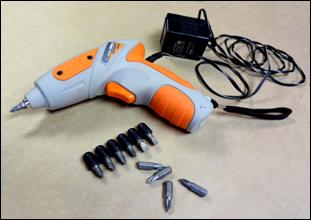
Once your painting is complete it will either be taken to your custom framer or you may frame it yourself. Commonly found tools, tapes and files readily available from local hardware and beauty supply stores can make do-it-yourself framing faster and easier for any artist/framer. A little knowledge can be extremely helpful and bring you one step closer to that professional framing presentation.
Screwdriver
Since hangers are an integral part of finishing a frame for display, screws are needed for hardware installation. Power screwdrivers are not new but there is a wonderful compact, lightweight gem available from Harbor Freight Rechargeable Cordless Screwdriver with 4.8V NiCd Battery Pack that comes with a plug-in charger for under $15 and often on sale for $10. The driver has a forward and reverse trigger as well as a built-in LED light for working in darker areas and is powerful enough for driving into wall headers and posts. Hex driver bits pull out for ease of changing from straight to Phillips and it comes with six tips. Inexpensive additional PH1 and PH2 Phillips screw tips are also available.

Burnishing Tools
Genuine bone folders come in a variety of sizes and shapes and are used for scoring paper, folding, smoothing raw cut mat window edges and activating pressure-sensitive adhesives. Burnishers are available as horn, stone, metal, wood, and synthetic but some can actually be sticky or transfer discoloration to mat board bevels and paper so bone is the best for framing. For perfectly squared paper, align one corner and full end of a sheet then run the bone along the folded edge from the squared side for a perfect alignment and crisp crease.
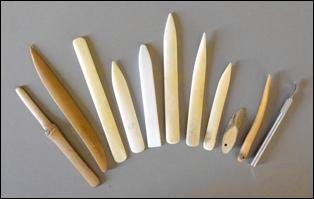
A new natural bone should be seasoned with oil prior to use, much like you would a new gourmet sauce pan. Liberally apply vegetable oil, to all sides of the bone and rub off any access with a clean absorbent cotton rag. Let it sit overnight to completely absorb the oil. The original white color of the new polished bone will appear more yellowed after oiling and will smoothly glide along the edge of cut paper or board. Older untreated bones will eventually take on the same aged look of a freshly seasoned one. This comes from natural hand oils being transferred to the bone as it is used....along with dirt and other alien substances, which may make the bone sticky.
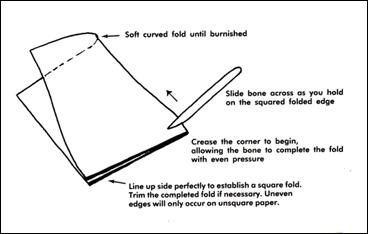
Bamboo Knife/Papercutter
The bamboo knife is a handcrafted tool for cutting traditional rice or mulberry paper. It is dominantly used as paper folder and cutter, but also serves to separate window mats that have been taped or glued together. The edge is thinner and sharper than a bone burnisher and since it is made from very large bamboo trunk so it is perfectly flat, strong and durable.
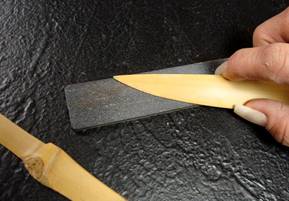
Sanding Sticks
Actually sanding sticks are nail files, with the best being Beauty Secrets #169400, as 7"x1"x⅛" thick, long rectangular, cushioned nail files from Sally Beauty Supply. The size makes them easy to grip while working and the square stable shape is well suited to edging techniques when trimming dust covers. They are washable sticks with grit both sides available in 100 course or 160 medium grades, though the 100 grade is best for framing needs and only .99 each. They also are perfect for creating manual deckle edges on heavy papers allowing for floating a finished painting.
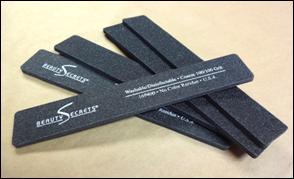
3M ATG-700™
ATG (Adhesive Tape Gun) applies a strip of ½" pressure-sensitive high-tack acrylic transfer tape to a surface allowing for another surface to be applied and adhered to it. The gun has a trigger system for ease of application. The adhesive comes in rolls applied to a paper liner that remains wound in the gun after application for removal once the roll is empty. This makes it clean and easy to use while applying a permanent, strong, clear adhesive for scrapbooking, paper crafts, sticking mats together, creating sink mounts, and applying dust covers.
Unlike film transfer tape, regular double-sided tape comes with adhesive applied to two sides of a carrier that stays with the tape once applied. Scotch #924 and acid free Scotch #908 are the most popular for artists. The #908 acid free is not designed for mounting artwork as pressure-sensitive adhesives should never be used in direct contact with fine art or any original painting. It is a medium tack acrylic adhesive with high initial grab. Though ATG tapes hold on contact, even with hand rubbing it is only activated about 25%. All pressure-sensitive products require more aggressive burnishing to activate and cure over time, usually 24 hours.
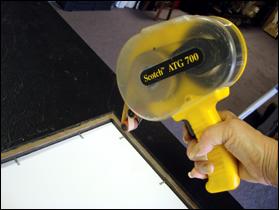
Dust Covers
A dust cover is the sheet that is taped or glued to the back of a completed frame to prevent dust, dirt and debris from getting into the package. It also retards pollution and bugs, although the little critters can eat through almost any paper, glue or tape. Papers are available in a variety of grades beginning with basic Brown Kraft paper, Black Kraft, Lineco Gray, and White Tyvek are the most common.
Brown Kraft paper quickly ages, gets brittle and yellows. Black Kraft paper is classy looking but has carbon in it that can leave a mark if bumped against a wall and will leave a ghost on any light colored wall over time even without direct contact to it. Lineco Dust Cover Paper is used most often in preservation framing practices. It is a 40 lb weight blue/gray, acid neutral, buffered paper available by the roll from Dick Blick. All Tyvek is neutral pH, tear, dust, mold & mildew resistant, and although porous for air circulation is also water resistant…something all other papers are not.
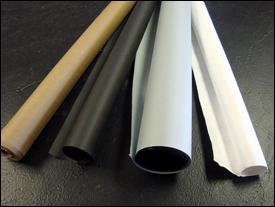
Dust Cover Step-by-Step Application
All your new tools may be used for application of a dust cover. Use your bone folder to crease selected paper 1-2" larger than the frame, then cut with a sharpened bamboo knife. Apply a continuous line of double sided tape with ATG gun to the back of the frame about ⅛" from the outer edge (as seen in photo 5).
 Apply the cut backing paper by squaring it to the far end of the frame and press firmly to attach to tape. Pull the loose sheet tightly and attach at center of opposite end by pressing firmly to tape.
Apply the cut backing paper by squaring it to the far end of the frame and press firmly to attach to tape. Pull the loose sheet tightly and attach at center of opposite end by pressing firmly to tape.
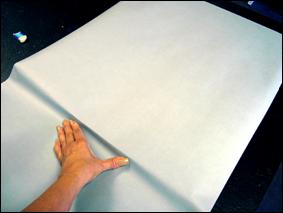 Snuggly pull paper to the table, creasing the paper and press against the adhesive along the full end edge to the corners.
Snuggly pull paper to the table, creasing the paper and press against the adhesive along the full end edge to the corners.
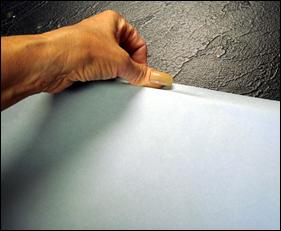 Beginning from center of the each side, pull and press the paper to the tape. Once snuggly pulled and pressed, firmly rub around the perimeter to hold.
Beginning from center of the each side, pull and press the paper to the tape. Once snuggly pulled and pressed, firmly rub around the perimeter to hold.
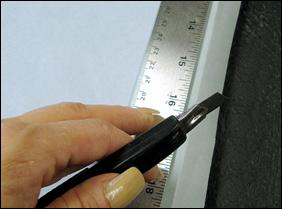 With a steel cork backed steel ruler and sharp knife trim excess paper from the edges ⅛" in from the frame exterior.
With a steel cork backed steel ruler and sharp knife trim excess paper from the edges ⅛" in from the frame exterior.
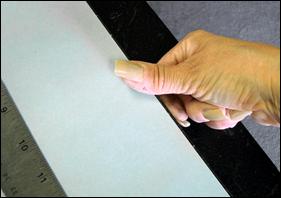 After trimming the paper, rub away any exposed tape adhesive along the outer edges, then burnish edges with a bone.
After trimming the paper, rub away any exposed tape adhesive along the outer edges, then burnish edges with a bone.
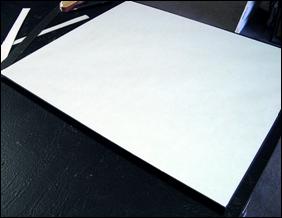 Attach wires for hanging with cordless screwdriver and add plastic or felt bumpers at bottom corners to lift bottom away from the wall, stabilize the frame and allow air circulation.
Attach wires for hanging with cordless screwdriver and add plastic or felt bumpers at bottom corners to lift bottom away from the wall, stabilize the frame and allow air circulation.
The finished dust cover will be taught and clean. Never use water, or a mister, a paper backing to tighten it. It could shrink unevenly and damage or break a narrow frame. Moisture should always be kept away from art and framing. Learn the correct method for application and the dust cover will always be taught without the addition of moisture. Also selecting heavyweight 45-60# papers makes dust cover application easier.
END
Copyright © 2014 Chris A Paschke
Resources—Items
http://www.blueheronarts.com—bamboo knife
http://www.dickblick.com—ATG700, 924 and 908 tape, Lineco paper, Kraft paper
http://www.fineartstore.com—bone folders, burnishers
http://www.framingsupplies.com—ATG700, 942,
http://www.harborfreight.com—4.8 Cordless Screwdriver, PH1 tips
http://www.misterart.com—ATG gun and tape, Kraft paper, bone folders,
http://www.orientalartsupply.com—bamboo papercutter (knife)
http://www.sallybeauty.com—Nail files
http://www.talas.com—bone folders, hand-crafted folders, Lineco paper
http://www.utrechtart.com—Kraft paper, ATG gun and tape, bone folders
For more articles on mounting basics look under the mounting section in Articles by Subject.
Additional information on all types of mounting is found in:
The Mounting and Laminating Handbook, Second Edition, 2002,
The Mounting And Laminating Handbook, Third Edition, 2008 and
Creative Mounting, Wrapping, And Laminating, 2000 will teach you everything you need to know about getting the most from your dry mount equipment and materials as an innovative frame designer.
All books are available from Designs Ink Publishing through this website.
Chris A Paschke, CPF GCF
Designs Ink
Designs Ink Publishing
785 Tucker Road, Suite G-183
Tehachapi, CA 93561
P 661-821-2188
chris@designsinkart.com